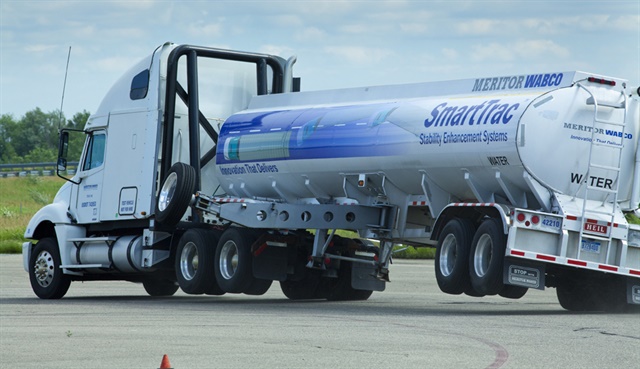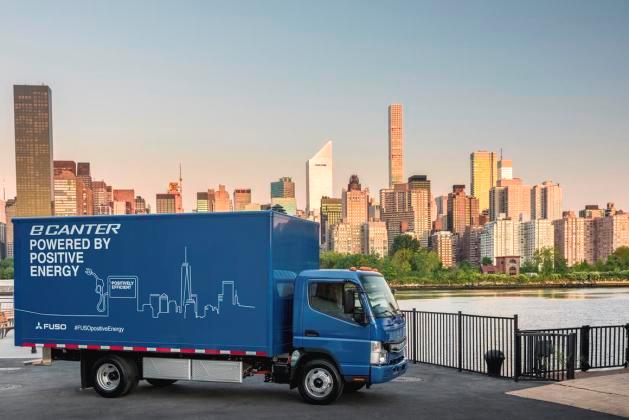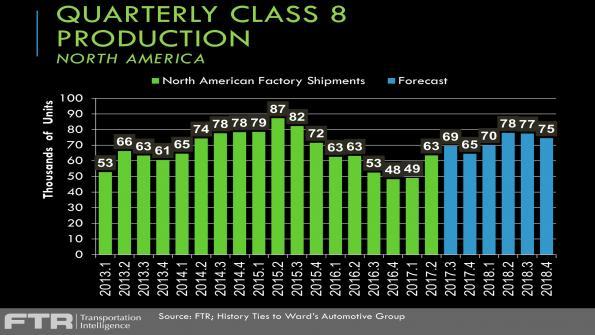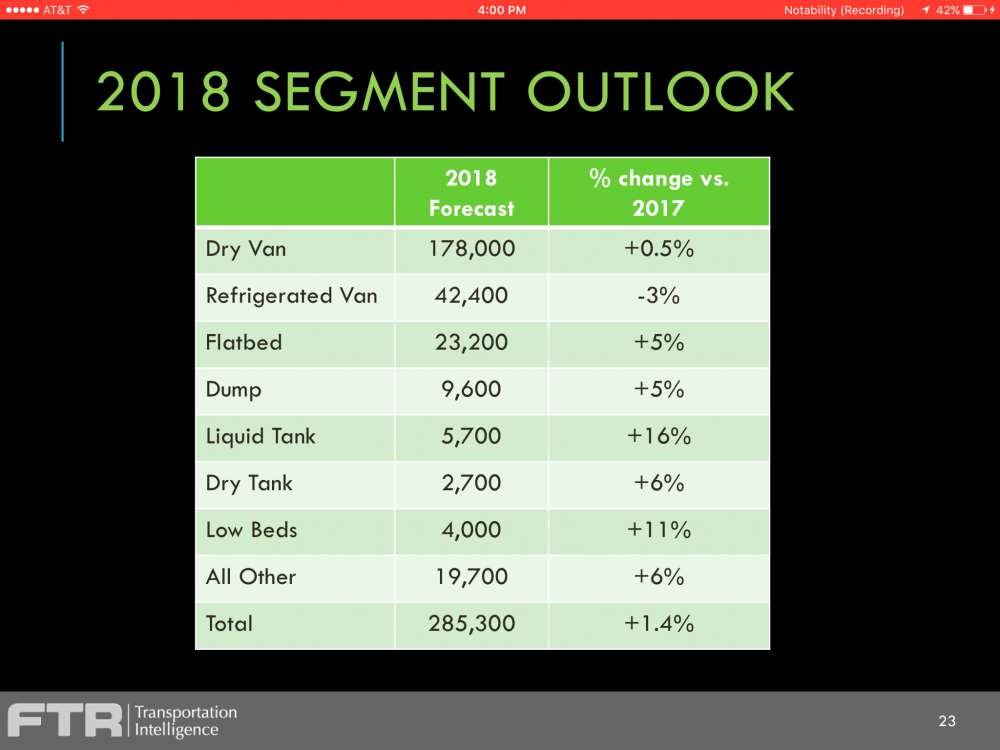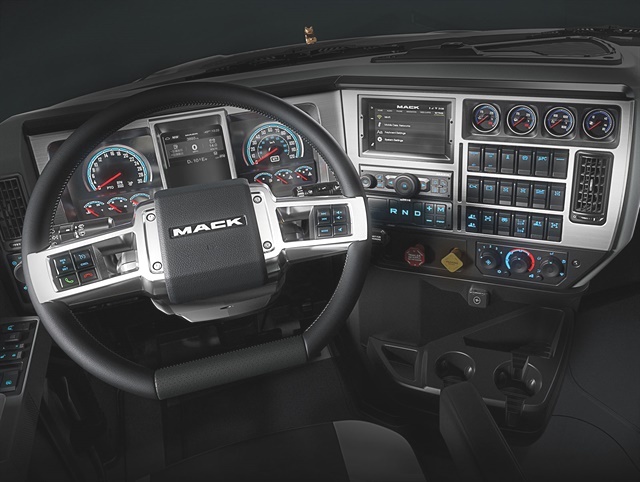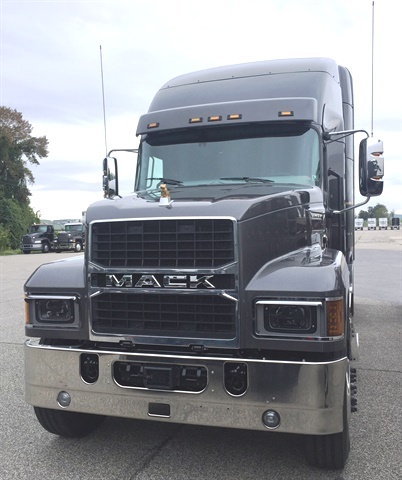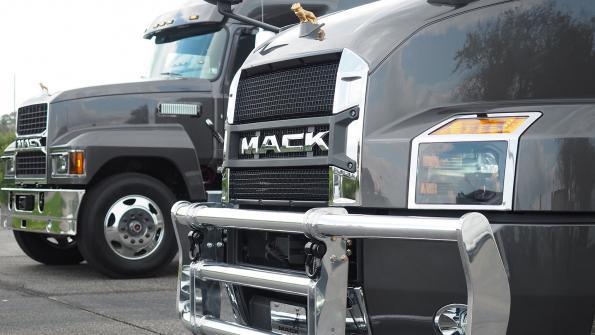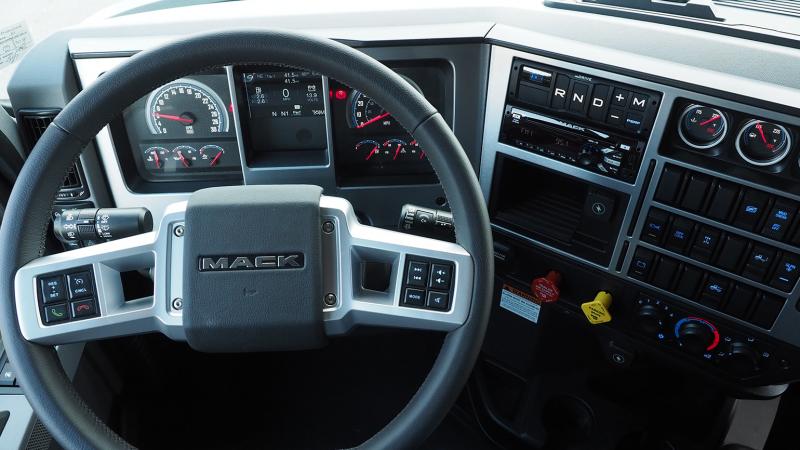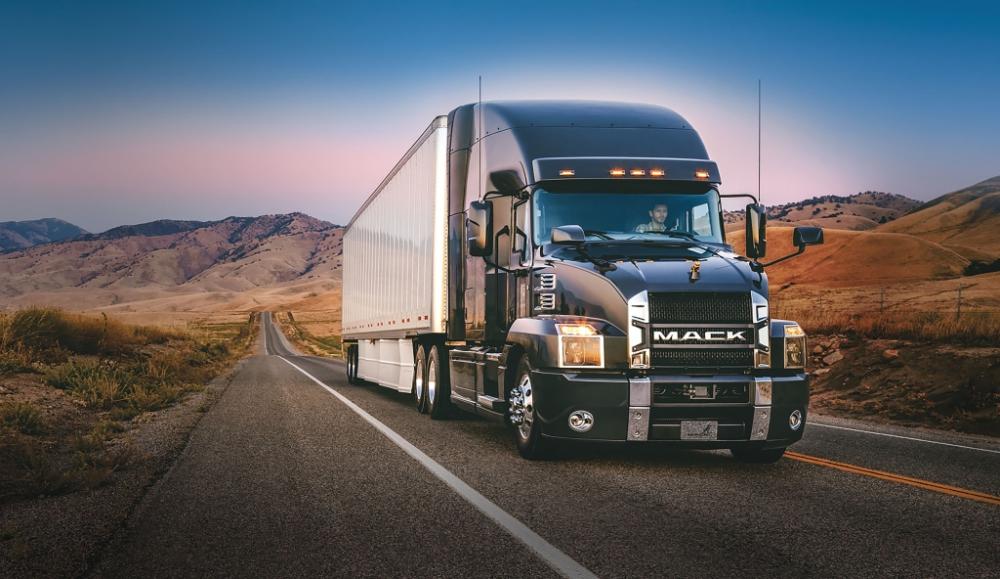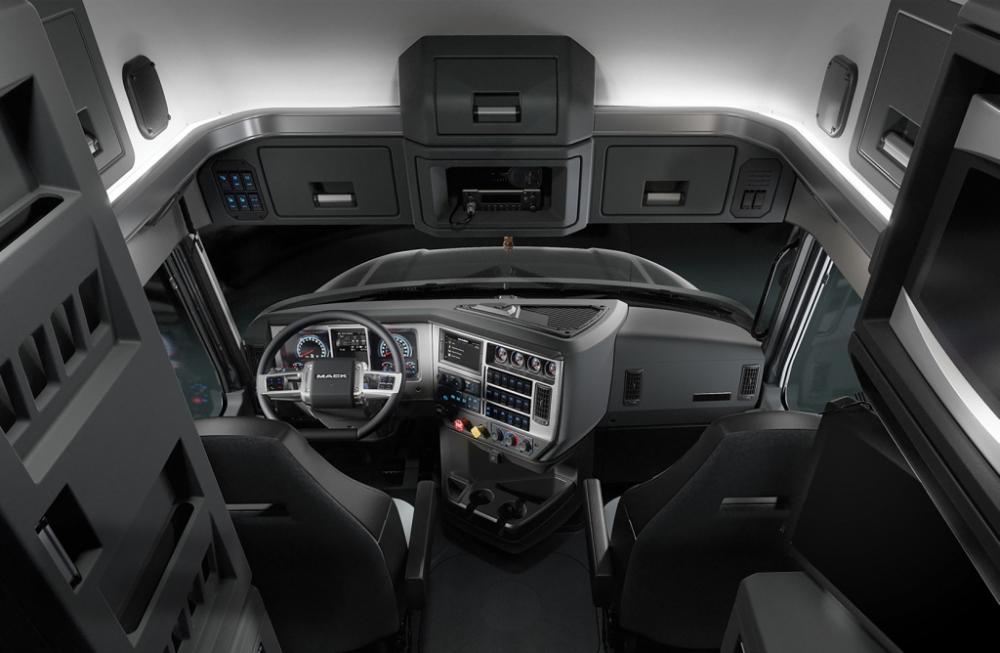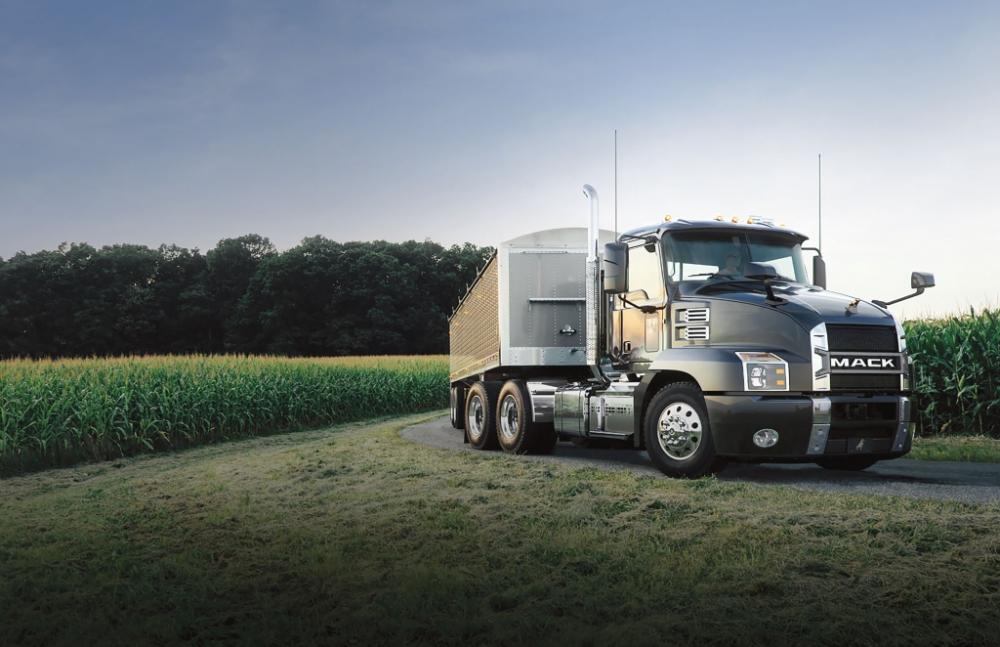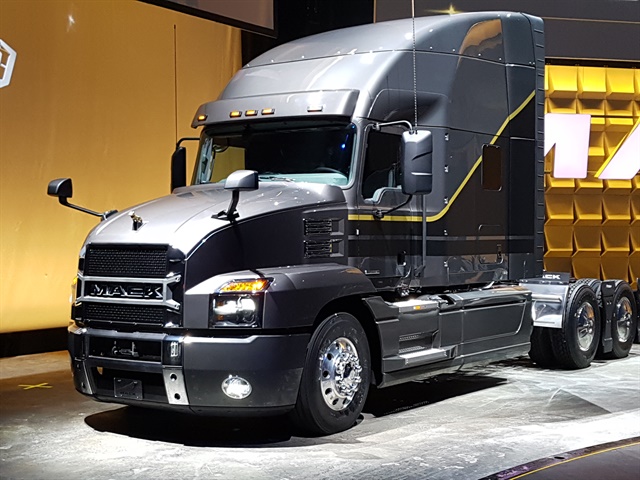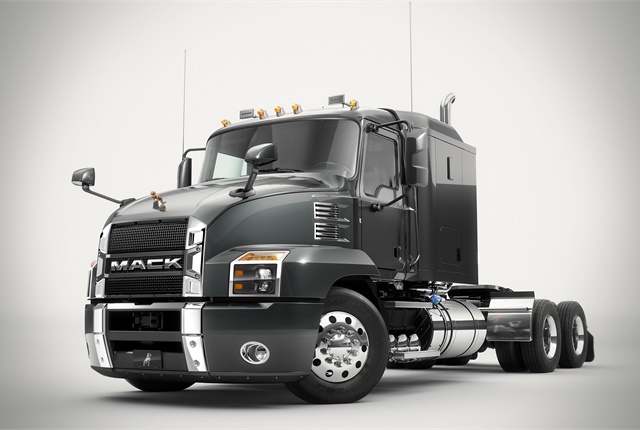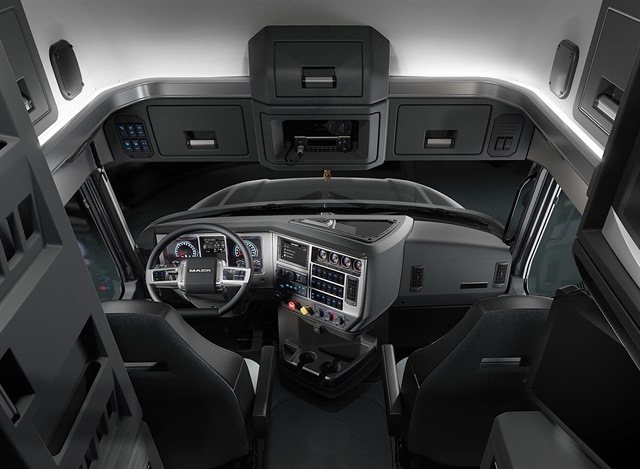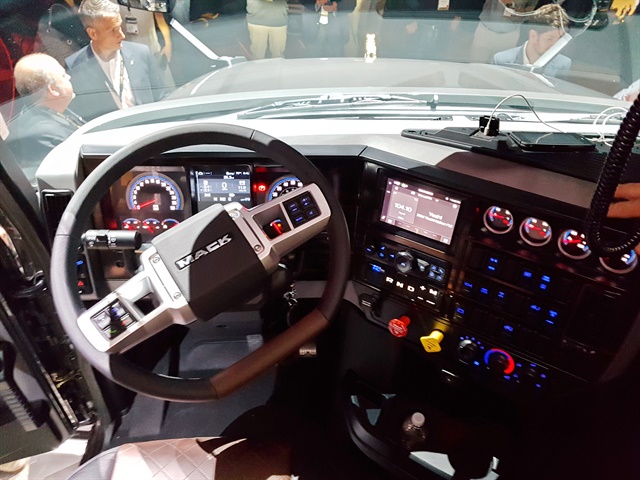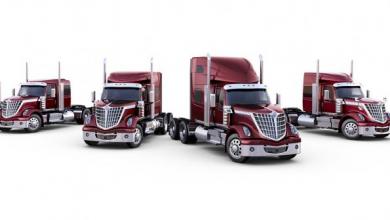
kscarbel2
Moderator-
Posts
17,893 -
Joined
-
Days Won
86
Content Type
Profiles
Forums
Gallery
Events
Blogs
BMT Wiki
Collections
Store
Everything posted by kscarbel2
-
Nikola and Bosch partner on hydrogen-electric Class-8 long-haul truck; dual-motor commercial-vehicle eAxle Green Car Congress / September 19, 2017 Nikola Motor Company is partnering with Bosch on the development of its hydrogen-fuel-cell range-extended electric Class 8 long-haul truck, unveiled as a prototype in December 2016. (Earlier post.) By 2021, Nikola intends to bring to market the Nikola One and Two, a class 8 hydrogen-electric truck lineup that will deliver more than 1,000 horsepower and 2,000 lb-ft (2,712 N·m) of torque—nearly double the horsepower of any semi-truck on the road—all with zero tailpipe emissions, as previously announced by Nikola. At the heart of the Nikola truck lineup is a new commercial vehicle powertrain achieved thanks to a development partnership between Nikola and Bosch. The organizations re-imagined the powertrain from the ground up. Bosch’s eAxle expertise (earlier post) has enabled Nikola to move quickly on an aggressive path to bring its electric truck to market. The eAxle developed by Bosch is a scalable, modular platform with the motor, power electronics and transmission in one compact unit. This makes it suitable for vehicles of all kinds, from small passenger cars to light trucks. Nikola and Bosch will use this know-how to commercialize the world’s first true dual-motor commercial-vehicle eAxle for a long-haul truck. The eAxle will use proven commercial vehicle electric machine technology and SMG (separate motor generator) motors from Bosch, and will realize what the partners call “unprecedented” targets for e-machine efficiency. The eAxles will be paired with a custom-designed fuel cell system—also being developed jointly between Nikola and Bosch—designed to deliver benchmark vehicle range. The overall vehicle controls will also be jointly developed based upon Bosch’s vehicle control software and hardware. The Nikola Bosch zero local emission powertrain is designed to achieve segment-leading performance at a competitive total cost of ownership to traditional powertrains. Bosch and Nikola will also jointly develop the overall powertrain system for the Nikola lineup, which will include the safety concept and vehicle electrical architecture.
-
The Land Rover Discovery shown has the same Ford 3.0 V6 diesel as the upcoming US market F-150. .
-
Class 8 production to top 300,000 units in 2018
kscarbel2 replied to kscarbel2's topic in Trucking News
Class 8 truck market to jump, stabilize in coming years James Jaillet, Commercial Carrier Journal (CCJ) / September 13, 2017 Despite their recent 18-month slump, Class 8 truck orders are forecasted by research firm FTR to jump to 247,000 this year and upwards of 300,000 in 2018 — a healthy rebound from lackluster orders seen in late 2015 and through all of 2016. Eric Starks, CEO and Chairman of FTR, offered his company’s forecast in a session Wednesday at the annual FTR Conference in Indianapolis. In addition to climbing orders this year and next, Starks predicts truck orders to remain stable over the next few years, projecting them to hover around 280,000 in 2019, 2020 and 2021. Numbers have trended above expectations this year, says Starks, and the prime order season — usually seen in October through December — still remains. FTR bases its forecast on a wide range of metrics, including consumer spending, freight movement, manufacturing output, business spending, inventory levels, housing starts and more. Though some continue to lag, such as inventory-to-sales ratios and business spending, other factors point to modest and continued growth. Consumer spending, for instance, has steadily climbed since the 2008-2009 recession. Manufacturing output has seen consistent growth in the last six months and spot market metrics reveal an ever-tightening environment. FTR also recently developed a new Class 8 order predictor, based on spot market data from Truckstop.com, and it has become a fairly reliable tool in predicting Class 8 truck orders, Starks said. “The estimator predicts big growth over the next few months,” he says. -
Nikola Developing Electric Truck Powertrain with Bosch Heavy Duty Trucking (HDT) / September 19, 2017 Nikola Motor Company and Bosch have teamed up to develop an electric powertrain designed for Nikola’s long-haul electric heavy-duty trucks. The development partnership will bring to market a fuel cell and commercial vehicle eAxle for Nikola’s Class 8 hydrogen-electric truck, slated for production by 2021. Nikola plans to launch the Nikola One and Two, daycab and sleeper versions of its electric truck, that promise 1,000 horsepower and 2,000 lb.-ft. of torque. The eAxle developed by Bosch is a scalable, modular platform, with the motor, power electronics and transmission in a single unit. It is designed to be suitable for vehicles of all kinds. Nikola and Bosch will use this technology to create a dual-motor commercial vehicle eAxle designed for a long-haul truck. Trevor Milton, CEO and founder of the Nikola Motor Company, recently told HDT that after the December 2016 unveiling of the Nikola truck, his design team went back and literally redesigned the truck from the wheels up. “We made a lot of improvement in that redesign and we’re in the final steps of that process now,” Milton says. “We’ll have trucks on the road in fleet tests in the third quarter of 2018.” The eAxles will be paired with a custom-designed fuel cell system – also being developed jointly by Nikola and Bosch – designed to deliver the desired vehicle range. The overall vehicle controls will also be jointly developed based upon Bosch's vehicle control software and hardware. Bosch and Nikola will also jointly develop the overall powertrain system for the Nikola lineup, which will include the safety concept and vehicle electrical architecture. "We have been aggressively pursuing our goal of bringing the most advanced semi-truck ever built to market," said Trevor Milton, Nikola Founder and CEO. "The powertrain requires an innovative and flexible partner able to adapt quickly to the speed of our team. Bosch has empowered us to come to market quickly with automotive-grade hardware and software so our vision can become a reality." "Breakthrough mobility technology requires visionary targets, speed to-market and disciplined structure to ensure long-term success," said Markus Heyn, member of the Bosch board of management responsible for the commercial vehicle organization . "Together with Nikola we are pushing ourselves to realize new levels of technological achievement and market penetration." .
-
Heavy Duty Trucking (HDT) / September 18, 2017 Belgium-based Wabco Holdings Inc. is expanding its operations in North America by taking full ownership of the Meritor Wabco joint venture. Wabco announced Monday that it has signed an agreement to Meritor’s stake in the joint venture business for $250 million. The transaction is expected to close on October 1. Meritor Wabco, employing about 200 people, is headquartered in Troy, Michigan, and had sales of $300 million in fiscal year 2016. It currently sells and distributes a range of Wabco’s safety and efficiency technologies for commercial vehicles in North America. The agreement to take full control of the joint-venture business will enable Wabco to offer, all under the Wabco brand, its consolidated portfolio of products and systems, including wheel-end solutions, air disc brakes, autonomous braking, electronic stability and active steering control systems, alongside advanced driver assistance systems (ADAS) and a full range of aerodynamic, air management and transmission automation control products in North America. “The acquisition of the remaining stake in Meritor Wabco furthers our commitment to expand our presence in North America,” said Jacques Esculier, Wabco chairman and CEO. Meritor intends to use the proceeds from the transaction toward its M2019 strategic priorities, which include paying down debt, funding strategic investments and repurchasing additional shares. "The decision to sell our interest in the JV enables us to focus on strategic priorities that involve growing our on- and off-highway, specialty, components and aftermarket businesses, among other things," said Jay Craig, Meritor CEO and president. Wabco says this consolidation of its business organization and broader access to market in North America will strengthen its relationships with commercial vehicle manufacturers and fleets through more simplified and direct channels. Wabco will take over the former joint venture’s application engineering and supply chain operations, including the distribution center and customer service hub in Hebron, Kentucky. In addition, Wabco will continue to have exclusive access to a winter test track in Sault St. Marie, Michigan, and joint access to a year-round test track in East Liberty, Ohio. Since 1990, the Meritor Wabco North American joint venture (originally Rockwell Wabco) has focused on the development and delivery of integrated safety technology and efficiency components, including braking systems and controls, active safety systems, and suspension and control systems, for commercial vehicles in North America. Following the closing, Meritor will continue to provide sales, service and training to Meritor Wabco customers through its DriveForce team for up to two years, and call center services for customer support and the processing of warranty claims for a period of approximately one year. In addition, Meritor will remain the exclusive distributor of a certain range of Wabco's aftermarket products in the United States and Canada, and the non-exclusive distributor in Mexico. Both parties have the option to terminate the distribution arrangements at certain points during the first three and half years, for an exercise price between $225 million and $265 million based on the earnings of the business. .
-
Daimler launches Mitsubishi Fuso eCanter in US market
kscarbel2 replied to kscarbel2's topic in Trucking News
Fuso launches zero-emissions light truck in New York Truck News / September 14, 2017 NEW YORK, N.Y. – Daimler Trucks’ Mitsubishi Fuso Truck and Bus Corp. celebrated the launch of the Fuso eCanter in New York City today, the world’s first series-produced all-electric light-duty truck. U.S., European and Japanese customers will receive their eCanter starting this year, with 500 expected to receive the vehicle in the next two years. “In times, when everybody is talking about electric trucks, we are the first to actually commercialize a series produced all-electric truck,” said Marc Llistosella, president and CEO of Mitsubishi Fuso Truck and Bus and head of Daimler Trucks Asia. “Having a long history in alternative drivetrains, we are proud to step into this new era. Our Fuso eCanter comes with years of customer testing, and the assurance of parts, services, and warranty through our global Fuso dealership network.” The first eCanter trucks were provided were provided to UPS and four New York City-based non-profit – Wildlife Conservation Society, New York Botanical Garden, Habitat for Humanity New York City, and Big Reuse Brooklyn. “At UPS, we constantly evaluate and deploy advanced technologies that enable sustainable, innovative solutions for our fleet,” said Carlton Rose, president of global fleet maintenance and engineering for UPS. “Electric trucks make our fleet both cleaner and quieter, adding to our already more than 8,500 alternative drivetrain vehicles in service today. We have a long-standing global relationship with Daimler, and we welcome the opportunity to trial the Fuso eCanter as UPS continues to realize the benefits of electric trucks.” . -
Fleet Owner / September 15, 2017 Construction clanking, sirens from emergency vehicles, and other typical city traffic noise served as the backdrop for Thursday’s global launch of Mitsubishi Fuso’s medium-duty electric delivery truck here in New York City’s East Village. The truck, called the eCanter, was unveiled by Mitsubishi Fuso Truck and Bus Corporation (MFTBC), part of Daimler Trucks, and has been touted as a zero-emission, zero-noise truck that will help transform urban areas, like New York City, “into cleaner and quieter places for everyday deliveries.” The truck, driven through the city by Fuso president and CEO Jecka Glasman, made its entrance at the corner of Lafayette and Great Jones, where Fuso converted an old gas station into its temporary “Energy Station of the Future.” Introducing the truck, Marc Llistosella, president and CEO of MFTBC and head of Daimler Trucks Asia, said some of the main trends he’s seen that will have major impacts on the trucking and bus industries are urbanization, emissions reduction, and energy efficiency. “We have been seeing more and more renewable, clean energy,” Llistosella explained. “There were a lot of hesitations and resistance, but now I would say [electrification] is coming.” Llistosella noted that 54% of the world’s population lives in cities, which has become a main driver for electrification and the need for clean trucks and buses. “Cities have a voice,” he noted. “It’s clear they want less pollution, less emissions and much less noise. We see a lot of tendencies and strong statements – from cities like Paris – that from 2040 on, they will no longer allow combustion-engine vehicles and trucks allowed into the cities. We will see changes driven by the cities.” One diesel-engine truck produces roughly 16 tons of CO2 in New York City, Llistosella explained. Assuming there are 10,000 trucks driving around Manhattan a year, they would emit 160,000 tons of CO2 a year, plus NOx emissions, and noise, he added. To offset that pollution, New York would need a forest the size of 36 Central Parks. New York City has put in place a plan to reduce emissions by 80% by 2050. Glasman added Fuso believes this truck is a “game-changer” for the city. “It will allow us cleaner, quieter, more efficient delivery systems to the people who live in New York,” she stated. “We expect to have 50 trucks that will be operating here in the U.S. by the end of the year.” The eCanter will be delivered to customers starting this year in the U.S., Europe and Japan. MFTBC noted it is planning to deliver 500 units of this generation to customers within the next two years. Larger scale production is intended to start in 2019. The eCanter has a range of more than 60 miles and a load capacity up to three and a half tons – depending on body and usage. The vehicle’s electric powertrain contains six high voltage lithium ion battery packs with 420 V and 13.8 kWh each. According to the company, when comparing the eCanter to a conventional diesel truck, it offers savings up to $2,000 per 10,000 miles on operating costs. At its global launch, Fuso also announced that UPS is the company’s first U.S. commercial partner for the eCanter. UPS said it will place in service trucks to build on UPS’s Rolling Laboratory fleet of more than 8,500 alternative fuel and advanced technology vehicles. “At UPS, we constantly evaluate and deploy advanced technologies that enable sustainable, innovative solutions for our fleet,” said Carlton Rose, president, global fleet maintenance & engineering, UPS. “Electric trucks make our fleet both cleaner and quieter. We have a long-standing global relationship with Daimler, and we welcome the opportunity to trial the Fuso eCanter as UPS continues to realize the benefits of electric trucks.” In coordination with the office of New York Attorney General Eric Schneiderman, Fuso also will supply a fleet of eCanter trucks to nonprofits, including Wildlife Conservation Society, New York Botanical Garden, Habitat for Humanity New York City, and Big Reuse Brooklyn.
-
Fleet Owner / September 15, 2017 North American Class 8 truck production will hit 300,000 units in 2018, a level seen only once in the past 10 years, according to the transportation equipment experts at FTR. In other forecasts presented at 2017 FTR Transportation Conference here this week, commercial vehicle trailer production will see a modest increase, paced by an improving flatbed market, while medium-duty truck production will mirror the U.S. economy, with slow but steady growth. Indeed, as goes the economy, so goes trucking. In the freight market, spot trends indicate that more loads are being posted with fewer trucks competing for them, resulting in a 19% rate increase over last year, explained FTR Chairman and CEO Eric Starks. “We are seeing noticeable rate pressure out there. We have not seen it moving into the contract rates, but I believe that we will see that very shortly,” Starks said—and that means carriers are in a better position to pay for things like drivers, and new equipment. In the FTR analysis of manufacturer backlogs, virtually all production slots are filled for the third quarter this year. “We have not seen that in long time. This suggests people are pushing for deliveries in the short term,” Starks said. “That is a very welcome sign.” FTR puts third-quarter Class 8 production at 70,000 units before taking a seasonal dip to 65,000 units in the fourth quarter. For 2018, production climbs back to 70,000 units in the first quarter, then finishes the year with totals of 78,000 in Q2, 77,000 in Q3, and 75,000 in Q4. “If you look at these numbers, we are not at levels we saw in 2014—but we are still at healthy, healthy levels going forward,” Starks said. But those FTR numbers might be optimistic, or at least premature, counters Jeff Kauffman, managing director at Aegis Capital Corp. Invited to present an “alternative” equipment forecast, he contends that improving market conditions won’t provide truckers the margins they need to make capital investments until mid-2018, pushing sales into 2019. “Most fleets have had the [equipment] numbers where they wanted them to be before this year, so there’s no catch-up on the heavy-duty side. We’re not looking at an aged truck fleet,” Kauffman said, explaining that his math puts 2018 Class 8 production at 265,000 units. “We’ve got ELDs coming, people are going to be hurting for drivers. Rates are going to go up, but we’re going to have to go out and hire drivers before we can buy trucks. I just don’t see 300,000 next year—maybe in 2019, after carriers have had a year of P&L under their belt, a year to figure out ELDs, after a year with better margins to put new drivers in training schools. Then I can see that happening.” Trailers As for commercial trailer production, FTR CV equipment expert Don Ake noted that he had substantially underestimated the U.S. dry van market in the 2017 forecast, expecting production to be 150,000 units, but which he now estimates to be 177,000 units for 2017—an 18% difference, but virtually the same level as 2015 and 2016. Ake attributes this consistency in the dry van segment to a lingering replacement cycle, as well as a limited pre-buy ahead of new trailer requirements under the new federal greenhouse gas emissions standards (GHG2), expected to add about $2,300 to cost of a new van trailer. Additionally, Ake suggested that the expected impact of the looming ELD mandate prompted fleets already using e-logs to add trailers this year, earlier than anticipated by “conventional thinking” which had pushed that demand into 2018, after the rule goes into effect. And while the replacement and pre-buy impacts come out of next year’s forecast, those losses should be offset by the demand associated with an improving freight market and tight truck capacity. As a result, he projects dry van production to remain flat, coming at 178,000 units in 2018. In contrast to the dry van market’s consistency over the past several years, the refrigerated market has seen new federal food safety rules and a “cultural shift” in consumer goods that ship as temperature-sensitive freight, prompting record reefer production in 2015 and 2016, before slipping this year after meeting that surge in demand. “The backlog on refrigerated vans is not looking very good right now,” Ake said, and he forecasts 2018 refrigerated van production to continue to slip, down 3% to 42,400 trailers. “I don’t think we’re going to need as many new reefers as we have in the last few years.” Flatbed, in contrast, is making a “stronger and faster comeback” than expected, based economy-driven demand for the segment, Ake explained, putting “upside pressure” on the forecast. “Dealers are back in the game, finally,” Ake said. “They’re ordering trailers, they’re stocking trailers, they’re selling trailers. They’re positive for the first time in a couple of years.” Ake expects a 5% jump in 2018, to 23,200 flatbed units. He also anticipates “a decent recovery” in the dump trailers (up 5%) and the liquid tank trailer forecast, based on improvement in the energy and chemical sectors, is “looking better, because they were so low,” resulting in 16% improvement. Medium-duty FTR COO Jonathon Starks points to a small increase in demand driven by the economy and a “normalized” replacement cycle as the basis for FTR’s forecast of a 1.4% increase in medium-duty commercial vehicle production (212,300 units, up from 209,300) —but that’s a 7.3% improvement from 2016 (197,800). “We had pretty strong numbers in the first half of this year, with some seasonal weakness built into the second half, so the full year numbers are stronger—and that sets us up for 2018,” Jonathon Starks said. “This isn’t significant growth, but it’s a very solid, stable, slow-growth environment. There’s some positive potential building for 2018, 2019, but it’s not transformational amounts; it’s incremental amounts.” .
-
Mack Updates Interiors on Pinnacle, Granite Heavy Duty Trucking (HDT) / September 11, 2017 Mack Trucks has updated its Granite and Pinnacle models with new, more driver-focused interiors aimed at attracting and retaining drivers, the company announced during the Mack Global Dealer Summit in Allentown, Penn. A new gauge cluster and dash layout is designed to improve visibility and readability and puts frequently used controls at the driver’s fingertips. Switches are repositioned higher on the dash, while the Mack mDrive automated manual transmission shift pad is now within easier reach as well. The dash panel has room for up to 18 switches, which feature laser etched labeling that won’t rub off, even after repeated use over the life of the truck. Along with interior changes, Mack has introduced LED headlights and a new grille for its Pinnacle model that echoes the design of its recently launched Anthem on-highway model. Mack also announced that the axle-back Pinnacle was being phased out in 2018 and would not receive the interior upgrade. The axle-forward Pinnacle, formerly known as the CH, will now be called the Pinnacle and is not being phased out. “The new interiors for the Mack Pinnacle and Granite speak to the design team’s focus on driver comfort,” said Jonathan Randall, senior vice president of sales for Mack Trucks North America. “Everything from the dash to the racecar-like feel of the steering wheel was carefully designed to make things better for drivers and owner-operators, and consequently, for fleets looking to retain them.” HVAC controls now include automatic temperature control that maintains the temperature set by the driver. A new lower center console includes cup holders and storage bins and can be easily removed for cleaning. Multiple 12-volt and USB charging ports are available throughout the dash. A new non-slip pad on top of the dash features two USB charging ports. The racecar-inspired flat-bottom steering wheel – a trucking industry first – improves driver comfort and makes entering and exiting the vehicle easier. The new steering wheel also gives the driver a better view of the dash and can be equipped with illuminated cruise control, Bluetooth and audio system buttons. Updates to Mack’s Co-Pilot display, located behind the steering wheel, include a new 5-inch, full-color screen for better visibility and more intuitive navigation through its many functions. Co-Pilot provides drivers a way to monitor vehicle information, including engine and oil temperatures, trip odometers, aftertreatment status, tire pressures and more. The Pre-Trip Assistant guides drivers through inspection points and includes a single person exterior light inspection mode. Controls for the Co-Pilot functions are located on the updated right-hand steering column stalk. “We’ve incorporated more ergonomics and comfort features to make the driving environment more automotive,” said Stu Russoli, Mack highway product manager. “These enhancements make a real difference to the driver who’s behind the wheel all day, every day.” .
-
Fleet Owner / September 14, 2017 ALLENTOWN, PA. Building on the launch this week of its Anthem highway tractor, Mack Trucks introduced new interiors for its Pinnacle axle-forward and Granite models designed to support customers in attracting and retaining drivers as well as improving productivity and profitability. Mack unveiled the updated models at its Global Dealer Summit here in Allentown. Along with the interior changes, Mack showed off LED headlights and a new grille for the Pinnacle that echoes the design of the Anthem; the redesigned interiors also share features with that of the Anthem truck. "The new interiors for the Mack Pinnacle and Granite speak to the design team's focus on driver comfort," said Jonathan Randall, senior vice president of sales for Mack Trucks North America. "Everything from the dash to the racecar-like feel of the steering wheel was carefully designed to make things better for drivers and owner-operators, and consequently, for fleets looking to retain them." Mack said it captured feedback from thousands of drivers in designing the new interiors and driver environment. A new gauge cluster and dash layout aims to improve visibility and readability and puts frequently used controls at the driver's fingertips. Switches are repositioned higher on the dash, while the Mack mDRIVE automated manual transmission shift pad is now within easier reach. The dash panel has room for up to 18 switches, which feature laser-etched labeling so it won't rub off like painted surfaces. HVAC controls now include automatic temperature control that maintains a temperature set by the driver. A lower center console includes cup holders and storage bins, and multiple 12-volt and USB charging ports are available throughout the dash. A new non-slip pad on top of the dash features two USB charging ports; drivers can place smartphones there for easy access or navigation use. The flat-bottom steering wheel is designed to make entering and exiting the vehicle or heading from the cab into the sleeper berth easier. The steering wheel also allows a better view of the dash and can be equipped with illuminated cruise control, Bluetooth and audio system buttons. Updates to Mack's Co-Pilot display located behind the steering wheel include a new 5-in. color screen for better visibility, and a new infotainment screen option features a 7-in. touchscreen display and is available in Pinnacle and Granite models. It provides access to Apple Car Play, satellite radio, weather band radio and TomTom truck navigation. .
-
Volvo introduces new Mack “Anthem” on-highway tractor
kscarbel2 replied to kscarbel2's topic in Trucking News
Mack Anthem: First drive and a look inside the cab Aaron Marsh, Fleet Owner / September 18, 2017 When you get inside and saddle up in Mack Trucks' new Anthem highway tractor, the word that may come to mind is "friendly." And then you'll notice how smooth it pulls. The Anthem's redesigned driver environment, which crosses over into the Pinnacle axle-forward and Granite models as well, puts controls within easy reach and provides more information at a glance to the operator. It does its intended job adeptly and it's an obvious refresh, actually making the Pinnacle and Granite feel like all-new trucks. Mack's mDRIVE HD automated manual transmission — which the company said has made big strides in the market since its introduction in 2015 to achieve an 88% penetration rate — offers simple, push-button operation. Available in 12-, 13-, and 14-speed versions with one or two low-ratio creeper gears, the mDRIVE gives the Anthem and other Mack models carlike drivability. Similarly capable are Mack's MP8 13L and MP7 11L diesel engines, which were included in Anthem models available for media test drives at Mack's Customer Center in Allentown, PA last week. With trailers loaded near weight limits in tow, it was easy almost to forget those trailers were there in drives around the test track (which we didn't do, of course). Speed around the test track is limited to 40 mph. Here are some photos and some more detail on the tractor's design from that first drive in Allentown. Photo gallery - http://fleetowner.com/trucks/mack-anthem-first-drive-and-look-inside-cab#slide-0-field_images-226491 -
Volvo introduces new Mack “Anthem” on-highway tractor
kscarbel2 replied to kscarbel2's topic in Trucking News
Heavy Duty Trucking (HDT) / September 19, 2017 “We have helped build America,” proclaimed Mack president Denny Slagle, referring to the company’s 117-year heritage. “We have arrived at an important milestone. This launch should be seen as a new day, a new start, a game changer for our beloved Mack brand.” “The Anthem has been part of our product strategy for the past several years,” said Roy Horton, Mack’s director - product strategy. And it’s a key rollout for the manufacturer, which despite double-digit market shares in segments like vocational, refuse, and regional trucking, accounts for about 2% of on-highway truck sales. The Anthem comes as a day cab, and with a 48-inch or 70-inch sleeper. Unlike the increasingly rounded shapes that have emerged in other designs, the Anthem’s profile features prominent edges and flat lines. But Mack stresses that the Anthem’s fuel economy is still 1.5% better than current Pinnacle axle-back tractors, and 3% better for those who spec’ the 70-inch stand-up sleeper. That’s on top of fuel economy gains realized with the company’s GHG17 engines. , -
Heavy Duty Trucking (HDT) / September 14, 2017 A good night's sleep is pretty important to an over the road driver. So Kenworth has designed a sleeper with lots of room and some special amenities. The 76-inch Driver's Studio sleeper package is a secure and relaxing place to spend your off-duty hours. Join Jim Park inside Kenworth's Premium Driver’s Studio sleeper to see what all the buzz is about. .
-
Heavy Duty Trucking (HDT) / September 14, 2017 When Kenworth launched the T680 in 2012, the company said it was the most aerodynamic truck it had ever built. A few things have changed since then, and the T680 has evolved, and it's not even more aerodynamically efficient. Jim Park takes a walk around tour of the truck, examining the T680's latest aero enhancements. .
-
Volvo introduces new Mack “Anthem” on-highway tractor
kscarbel2 replied to kscarbel2's topic in Trucking News
. -
Volvo introduces new Mack “Anthem” on-highway tractor
kscarbel2 replied to kscarbel2's topic in Trucking News
Volvo introduces Mack Anthem highway model James Menzies, Truck News / September 14, 2017 ALLENTOWN, Pa. – In designing its new Anthem highway tractor, Mack Trucks set out to challenge the idea that an efficient truck has to be shaped like a “jelly bean.” And the Anthem, to be sure, will throw a different shadow on the ground than any of its competitors. The Anthem, according to Mack, will produce 3% better fuel economy than the Pinnacle in a 70-inch sleeper configuration, and a 1.5% improvement as a day cab. This despite its large square headlights, many sharp edges, and bold, angular design. The much-anticipated truck was shown to dealers and truck press for the first time at an unveiling here Sept. 13. It looks nothing like the new models bro-brand Volvo introduced earlier this year, and has managed to capture the distinct styling befitting a Mack, in a package that the company says will be competitive in terms of fuel economy. “Our main goal was to design something that looks like a Mack,” said Stu Russoli, on-highway product manager with Mack Trucks. “It’s gotta be bold, it’s gotta look like a Mack.” The company spent five years designing the new Anthem, beginning the process with visits to truck stops, where designers traded meal vouchers for truck tours, to see exactly how drivers were living in and utilizing their trucks, regardless of make. “We asked if we could go into their truck, look around, see how they lived,” Russoli recalled. “We needed to make it look like a Mack, that was our request to designers. It also needs to be aerodynamic, and then we go into driver comfort.” Russoli noted the strong vertical and horizontal lines on the front end of the truck, designed to be “structural.” A bold MACK across the grille has been dubbed the bridge. “It’s very structural, very strong, very Mack,” explained Russoli. But despite the departure from the traditional slippery truck design, Mack says the new truck is also fuel efficient. The hood has a different contour than the Pinnacle, to better direct airflow up and over the cab. Swept-back fenders direct air along the side of the trailer. And a new aerodynamic sun visor also helps direct airflow up over the cab. Other aero improvements include a close-out flange between the bumper and hood, and new bumper air dams, as well as covered tow hooks – all designed to reduce wind resistance. Optional hood-mounted mirrors are placed on top of the hood, so they’re higher up, and also align with the side mirrors to minimize the disruption to airflow. A one-piece composite roof protects against leaks, but doesn’t allow for a skylight, something Russoli said was a frequent complaint from drivers who found them prone to leakage and to let in too much light at nighttime. The larger 70-inch stand-up sleeper provides more interior headroom and living space for drivers. All lights on, and inside, the new Mack Anthem are LED, requiring less power draw and providing a whiter light. The LED headlights, Russoli said, provide 66% better brightness. The hood takes 50% less effort to open, and uses a single point hood latch so drivers no longer have to circle to both sides of the hood to release latches. A three-piece hood and bumper, as well as breakaway hood and side mirrors, were designed to reduce replacement and repair costs. Inside the cab, the dash was redesigned to put controls within closer reach of the driver. Eight switches have been moved to the steering wheel – but a base steering wheel without buttons is also available. The steering wheel is the industry’s first with a race car-inspired flat bottom, which was done for styling, but also to afford more belly room and to make it easier to slide in and out of the driver seat. As part of the design process, Mack designers also visited used truck lots to see first-hand how trucks aged. They found issues such as worn rocker switches, which had become difficult or impossible to read. In the Anthem, switches have been laser-etched so the markings last. The interior has a seven-inch touchscreen infotainment system, featuring TomTom truck navigation, Apple CarPlay, an optional backup cam, and satellite radio. The Mack CoPilot driver information center now features a five-inch, full-color screen. The Anthem comes with a new line of Sears seats, which can be had in more than 30 feature and fabric combinations. The interior also boasts more storage – 27 cubic feet – which Mack says is the most in the industry. Pop-out side windows allow light and air into the bunk, and keep out rain due to the hinge-topped design. The new Mack Anthem will go into production in the first quarter of 2018, and will replace the Mack Pinnacle axle back model. The Pinnacle axle-forward model will carry on, as the Mack Pinnacle. Truck News editor James Menzies will be driving the Mack Anthem from Allentown, Pa., to Atlanta, Ga., this week, in advance of the North American Commercial Vehicle Show, where it will make its public debut. Check back soon for a more detailed, first-hand driving report. . -
Volvo introduces new Mack “Anthem” on-highway tractor
kscarbel2 replied to kscarbel2's topic in Trucking News
Volvo rolls out new Mack Anthem highway truck Aaron Marsh, Fleet Owner / September 14, 2017 ALLENTOWN, PA. With a bold new grille sporting vertical accents like two fangs in a bulldog's underbite, Mack Trucks' new Anthem highway tractor drew multinational press and plenty of fanfare at its launch here Wednesday evening. That included video of the truck's development, where designers and Mack execs touted the Anthem's brawny look and aero-functional design as "bad ass" and destined to become a classic looking back in the years to come, as the OEM's big trucks of decades past have. "In terms of powertrain, in terms of connectivity, in terms of comfort, uptime, productivity, durability, and application excellence, it's a platform that we provide all the things that we need in order to move forward," said Martin Lundstedt, president and CEO of Volvo Group, Mack's parent. He promised a "high pace and high frequency" of continued investment in Mack's products, production facilities and service network, acknowledging Mack dealers' own investments in facilities and technician training. Denny Slagle, executive vice president of Volvo Group and president of Mack trucks, highlighted Mack's latest powertrains featuring engines compliant with 2017 fuel efficiency/ greenhouse gas emissions requirements and mDRIVE automated manual transmission as "frankly, producing a drive that can't be matched by the competition." The Anthem — which features an engraved American flag in its badging — is "the right highway truck for North America" and "captures everything that has made Mack great," contended John Walsh, Mack's vice president of global marketing and brand management. He said the new truck was designed to be "unmistakably Mack," offer superior aerodynamics and fuel efficiency without looking "like a jelly bean," and deliver "revolutionary" driver comfort. "We are proud to be the only heavy-duty truck manufacturer who can still say that every truck we sell in America is built here in America," Walsh added. He highlighted a list of new exterior, driver environment and sleeper/ living environment features and options. EXTERIOR —New grille, with a bridge across the front bearing the "big, bold" Mack word moniker; —Three configurations: day cab, 48-in. flat-top sleeper, and 70-in. stand-up sleeper designed to allow even taller drivers ample room to stand freely in the rear; —Available aero-enhancing roof fairing; —Better visibility than current Pinnacle highway models; —Improved aerodynamics that provide up to a 3% fuel efficiency gain with the 70-in. stand-up sleeper model and 1.5% gain with the day cab model in addition to 2017 powertrain fuel efficiency gains; —Two trim packages, "Bold Black" and "Mirror Chrome Bright," incorporated into the grille, bumper, headlamp and fog lamp bezels, and air intakes; —Three-piece bumper designed for improved serviceability and lower repair costs in case of damage; —LED headlamps, turn signals, fog lights and marker lights are longer-lasting, use less energy and are up to 66% brighter than incandescents; —New three-piece hood that can be replaced in sections if damaged, features an automotive-style release latch in the grille, and requires 50% less effort to tilt open; —Aerodynamic hood mirrors that reduce drag, deliver an improved field of view/ reduced blind spots, and fold away on impact; —Breakaway side mirrors feature stronger materials, hinges and spring-loaded mounts; and —Grab handles made of thick, extruded aluminum and tactile, contoured surface. INTERIOR —Three available trim levels: standard, premium and ultra; —New driver environment featuring automotive-inspired controls in the instrument panel, digitally displayed analog gauges, and 5.5-in. color Copilot display; —Flat-bottom steering wheel designed for solid grip and easier entry and exit; —Steering wheel can be spec'd with "smart' features including illuminated controls for cruise, Bluetooth and infotainment; —Redesigned steering column stalks: right manages engine brake and Copilot display, left manages high beams, turn signals and windshield wipers; —Optional 7-in. infotainment display in console can display tools like Sirius XM, truck navigation, Apple Carplay and backup cameras; —New rocker switches in dash with laser-etched labels that won't fade or rub off, with standardized key switch placements across models but additional slots available for customization; —Non-slip-surfaced mobile phone charging station on top of dash; —Power windows, locks and mirrors; —Lights managed through automotive-inspired control module; —Seats designed in partnership with Sears for comfort and durability, offering 30 feature-function combinations; and —Redesigned "doghouse" over the engine to provide easier access/ serviceability. SLEEPER —70-in. stand-up model allows driver to stand up next to driver's seat and walk into sleeper, which provides 35% more space; —Improved accommodation for driver's gear with up to 27 cu. ft. of space in 70-in. sleeper model, with more work surfaces, wardrobes and shelving; —All-LED interior lighting, including "ambient," "task" and "background" lights; —Prep kits available with wiring for refrigerator, flat-screen TV and microwave; —Multiple electrical and USB outlets; —Tilt-open sleeper windows with built-in shades and screens that allow ventilation but keep rain out; —Sleeper curtain that darkens living space; and —Available single or double bunk beds. Photo gallery - http://fleetowner.com/trucks/mack-rolls-out-new-bad-ass-anthem-highway-truck#slide-0-field_images-226311 -
Jim Park, Heavy Duty Trucking (HDT) / September 13, 2017 ALLENTOWN, PA. – Mack Trucks introduced its new, next-generation highway hero, the Mack Anthem, during the Mack Global Dealer Summit in Allentown Wednesday night. Mack calls the Anthem a re-engineered, redesigned and reimagined interpretation of what today’s highway truck should be – aerodynamic, comfortable, and connected, with a bold Mack look. “As one of the most significant new trucks in Mack’s 117-year history, the Anthem combines our latest innovations with more than a century of truck-building know-how,” said Dennis Slagle, president, Mack Trucks. “The incredible result is a truck that’s been built for our customers’ business and designed for drivers, all while delivering the power and presence that only a Mack truck can deliver.” The Mack Anthem features an all-new exterior design with optimized aerodynamics for improved fuel efficiency. New driving and sleeping environments were crafted with an emphasis on increasing driver comfort and productivity. The Anthem is available in several configurations, including a daycab, an all-new 48-inch flat top sleeper, and an all-new 70-inch stand-up sleeper. “Every detail on the Anthem was designed with purpose,” said Jonathan Randall, senior vice president, sales, Mack Trucks North America. “We surveyed thousands of drivers and incorporated their feedback to deliver a functional, strong, efficient highway truck with an authentic design unlike anything on the road today.” The Anthem is available with the 13L Mack MP8 engine with ratings as high as 505 hp and 1,860 lb.-ft. of torque. Several enhancements to improve efficiency and productivity are included, such as a patented wave piston design that enables more complete fuel combustion and a common-rail fuel system to more accurately control fuel injection. The 11L Mack MP7 is available as an option on the Anthem with ratings up 425 hp and 1,560 lb.-ft. of torque. Mack’s SuperEconodyne downspeeding packages are available with both Mack MP7 and MP8 engines. Available exclusively with SuperEconodyne is the Mack MP8-TC engine featuring turbo compounding. The Mack MP8-TC captures and converts waste energy from the exhaust into mechanical energy that is fed back to the engine. The turbo compounding system feeds up to 50 additional horsepower back to the crankshaft, enabling additional performance while improving fuel efficiency. Combined with the Anthem’s aerodynamic improvements, the Mack MP8-TC engines provide up to an 11.8% improvement in fuel efficiency compared with a baseline from previous Mack models equipped with GHG2014 engines. “The MP8-TC is ideal for customers whose applications involve long, steady-state cruising on routes with terrain ranging from flat to rolling hills,” said Scott Barraclough, Mack technology product manager. “The turbo compound unit allows the MP8-TC to deliver full torque as low as 900 rpm, allowing for fewer downshifts and improved efficiency.” Mack’s 12-speed mDrive automated manual transmission is standard on all Anthem models. The Mack Anthem features an all-new driving environment that incorporates driver feedback for improved functionality, ergonomics and convenience. Gauges on the instrument panel have been positioned higher for better driver visibility, while HVAC controls and the Mack mDrive AMT shift pad have been relocated closer to the driver’s fingertips. All switches for additional truck functions like cruise control, PTOs and traction control now feature laser etching to help maintain markings over the long life of the vehicle. Inspired by racecar controls, a new flat-bottom steering wheel is a Class 8 trucking industry first, providing improved dash visibility, as well as easier ingress and egress. The all-new 70-inch sleeper now features stand-up height for even tall drivers to easily walk-through the cab into the living environment. The interior volume of the new sleeper is 35% larger than previous models. Anthem's 70-inch stand-up sleeper models are available in single or double bunk configuration. During the unveiling ceremony, Walsh said the truck's name is a tribute the company and Mack's extended family. "The Anthem is the right highway truck for North America," said Walsh. “We are an American brand. We were born here. We were raised here, and we literally helped build this country. The name Anthem speaks to that American spirit." We'll have more on the Anthem coming soon, following a detailed briefing from Mack engineers, designers and executives over the next couple of days. Equipment Editor Jim Park will be participating in an extended test drive later this week, driving an Anthem from Allentown to Atlanta. .
-
Kenworth T680 with PACCAR MX engine to join SuperTruck II project Fleet Owner / September 13, 2017 PACCAR joins four other SuperTruck II teams working to more than double the freight efficiency of Class 8 trucks. Kenworth announced that it will collaborate with the PACCAR Technical Center and DAF Trucks NV to develop advancements in Class 8 truck aerodynamics, engine and powertrain efficiencies with $8 million in year-one funding provided by the Vehicle Technologies Office of U.S. Department of Energy (DOE) SuperTruck II program. Other partners include Eaton, National Renewable Energy Laboratory (NREL), Mississippi State University, and AVL. The project will utilize the company’s on-highway flagship Kenworth T680 with the 76-inch sleeper and the PACCAR MX engine. “The U.S. DOE SuperTruck II project is an excellent opportunity for Kenworth, the PACCAR Technical Center and DAF engineers, along with our partners, to explore significant modifications to aerodynamic design, while also developing key ways to further enhance the efficiency of the PACCAR MX engine and PACCAR powertrain,” said Mike Dozier, Kenworth general manager and PACCAR vice president. “This is an important program that can produce real-world results to benefit fleets and truck operators with even greater reductions in fuel usage and emissions in the future,” he added. PACCAR joins four other SuperTruck II teams working to develop such innovative technologies designed to more than double the freight efficiency of Class 8 trucks. Up to $12 million in additional funding could be awarded for the Kenworth T680 and PACCAR MX engine project over the next three years, subject to annual appropriations by Congress, which has been very supportive of the SuperTruck II initiative.
-
Navistar makes enhancements to LoneStar tractor Sean Kilcarr, Fleet Owner / September 11, 2017 OEM upgrades tractor’s interior to improve driver ergonomics, visibility, and ultimately productivity. It will be available in early 2018. The International Truck division of Navistar is rolling out what it calls “major enhancements” to its LoneStar highway tractor; deliberately dovetailing the announcement with the start of National Truck Driver Appreciation Week to highlight the “driver-focused” upgrades to its LoneStar family of trucks, originally introduced back in 2008. “These benefits move the needle in this ‘advanced classic’ segment,” David Majors, Navistar’s vice president of product development, noted in a conference call with reporters regarding the LoneStar upgrades, which will become available in January 2018. “This vehicle is really like a Porsche; it has a very distinctive style when it comes down the road. It’s always had iconic style but now we’re refining it,” he explained. “We’re combining form and function better to provide an outstanding environment for the driver while making aerodynamic improvements to boost fuel economy.” Majors said hood design changes and new seven-pound-lighter pedestal mirrors when combined with the new Cummins X15 engine models available for the LoneStar improve fuel efficiency by 3% versus previous iterations of the vehicle. He pointed out, however, that Navistar’s new A26 engine will not be available for the company’s retooled LoneStar model. Some examples of the LoneStar upgrades include: A new single-canister aftertreatment system provided by Cummins, the LoneStar’s engine supplier, that is 60% smaller and 40% lighter than the previous two-part system and is also simplified for quicker servicing. An all-new cab wiring harness package and in-cab power distribution module that is inside the truck, away from the elements. An all-new HVAC [heating, ventilation and air conditioning] system delivers outstanding comfort and visibility with faster defrosting capabilities. During testing at 0°F, the company said the LoneStar’s “MAX” defrosting setting cleared 100% of the windshield in under 30 minutes from start-up. The doors on the LoneStar now open 4% wider, are two-times as stiff, and feature more seal compression to help reduce cab noise, Majors noted. “Lower NVH [noise, vibration, harmonics] reduces driver fatigue for long haul,” he said. Door handles are wider and deeper to accommodate use when wearing gloves. Indeed, Majors said most of the rocker switches on the LoneStar’s redesigned dashboard can now be operated when wearing gloves. The steering wheel buttons now feature laser-etched descriptions and are backlighted as well. “We had complaints about the markings wearing off over time and being hard to see as well – drivers were taking their eyes off the road to find the right switch,” Majors said. The revamped LoneStar will also feature an all new ergonomically designed interior with new digital information display, a new integrated stalk shifter integrating transmission and engine brake functionality, durable and easy to clean soft touch vinyl interior, and stylish diamond interior is standard, said Majors Drivers will notice that the doors, side glass and cab mirrors have all been redesigned to enhance visibility and ultimately helping to reduce neck strain and fatigue over the long haul, he added – with 15% less head turning needed to the left and 5% less to the right for maximum side-window visibility. The LoneStar is available in several configurations, Navistar noted: Daycab, 56-in. low roof sleeper, 56-in. high-rise sleeper, 73-in. high-rise sleeper, and a 73-in. “Sky-Rise” sleeper package. The LoneStar is not typically spec’d for vocational applications, though Majors noted some are being sold into the heavy-wrecker segment. .
-
Volvo Unveils Next-Generation VNL Highway Tractor
kscarbel2 replied to kscarbel2's topic in Trucking News
Diving into VNL design details Sean Kilcarr, Fleet Owner / September 10, 2017 The retooled Volvo VNL family of highway tractors built by Volvo Trucks North America, which the OEM originally unveiled back in July, incorporates many subtle design changes indicative of a more driver-focused mentality by the truck manufacturing industry as whole. That includes adding in more storage space within the tractor cab, more “comfort” features such as heated and cooled seats, plus other tweaks aimed at making operating a truck an easier task. Photo gallery - http://fleetowner.com/trucks/diving-vnl-design-details#slide-0-field_images-225971 -
Kenworth to participate in SuperTruck II project Truck News / September 12, 2017 KIRKLAND, Wash. – Kenworth announced this week that it will collaborate closely with the Paccar Technical Center and DAF Trucks NV, a subsidiary of Paccar, to develop important advancements in Class 8 truck aerodynamics, engine, and powertrain efficiencies with $8 million in year-one funding provided by the Vehicle Technologies Office of U.S. Department of Energy (DOE) SuperTruck II program. The project will utilize the company’s on-highway flagship Kenworth T680 with the 76-inch sleeper and the fuel-efficient Paccar MX engine. The project’s target goals include the demonstration of greater than 100 percent improvement in freight efficiency over 2009 equivalent product, and achieving 55%t in engine brake thermal efficiency. “The U.S. DOE SuperTruck II project is an excellent opportunity for Kenworth, the Paccar Technical Center and DAF engineers, along with our partners, to explore significant modifications to aerodynamic design, while also developing key ways to further enhance the efficiency of the Paccar MX engine and Paccar powertrain,” said Mike Dozier, Kenworth general manager and Paccar vice-president. “This is an important program that can produce real-world results to benefit fleets and truck operators with even greater reductions in fuel usage and emissions in the future.” PACCAR joins four other SuperTruck II teams working to develop such innovative technologies designed to more than double the freight efficiency of Class 8 trucks. Up to $12 million in additional funding could be awarded for the Kenworth T680 and Paccar MX engine project over the next three years, subject to annual appropriations by Congress, which has been very supportive of the SuperTruck II initiative.
-
Heavy Duty Trucking / September 11, 2017 Kenworth has announced that it will participate in the Department of Energy’s SuperTruck II program, collaborating closely with the Paccar Technical Center and DAF Trucks, a subsidiary of Paccar, to develop fuel efficient technologies. The company’s focus is on developing advancements in Class 8 truck aerodynamics, engine, and powertrain efficiencies with $8 million in year-one funding, provided by the Vehicle Technologies Office of the DOE. Other participants include Eaton, National Renewable Energy Laboratory, Mississippi State University, and AVL. The project will center around Kenworth’s flagship on-highway model T680 with the 76-inch sleeper and the fuel-efficient Paccar MX engine. The project’s target goals include the demonstration of greater than 100% improvement in freight efficiency over 2009 equivalent product and achieving 55% in engine brake thermal efficiency. “The U.S. DOE SuperTruck II project is an excellent opportunity for Kenworth, the Paccar Technical Center, and DAF engineers, along with our partners, to explore significant modifications to aerodynamic design, while also developing key ways to further enhance the efficiency of the Paccar MX engine and Paccar powertrain,” said Mike Dozier, Kenworth general manager and Paccar vice president. “This is an important program that can produce real-world results to benefit fleets and truck operators with even greater reductions in fuel usage and emissions in the future.” Paccar joins teams from Cummins, Daimler Trucks North America, Navistar, and Volvo, in the SuperTruck II program, working to develop innovative technologies designed to more than double the freight efficiency of Class 8 trucks. Up to $12 million in additional funding could be awarded for the Kenworth T680 and Paccar MX engine project over the next three years, subject to annual appropriations by Congress. Kenworth sister company Peterbilt participated in the original SuperTruck program in a joint effort with Cummins, which debuted its vehicle in 2014, achieving 10.7 miles per gallon.
BigMackTrucks.com
BigMackTrucks.com is a support forum for antique, classic and modern Mack Trucks! The forum is owned and maintained by Watt's Truck Center, Inc. an independent, full service Mack dealer. The forums are not affiliated with Mack Trucks, Inc.
Our Vendors and Advertisers
Thank you for your support!




